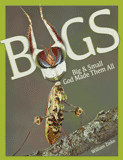
Bitter Butterfly
Abstract
The viceroy is a colorful butterfly native to the United States that is known to mimic other species. However, the viceroy is not just a tasty option that looks like the unpalatable models it mimics. It has its own chemical defenses. These traits become especially prominent when the other model species are not present. A recent study attempted to demonstrate mimicry and how it evolved in the viceroy butterfly. However, limited experimental design and faulty assumptions undercut the study.
The origin of mimicry has always been troublesome for evolutionary dogma. Mimicry occurs in numerous groups of animals and provides a benefit to at least the mimic. However, according to many evolutionists, such as Richard Dawkins, evolution is merely a string of unordered events with “no purpose in mind.”1 Given Dawkins’ belief system, mimicry is indeed a significant problem. No one study can address all of the issues with mimicry for the concept of naturalistic evolution, but one recent research attempted to explain the evolution of mimicry in viceroy butterflies (Limenitis archippus). The study examined how palatable they were to predators and whether their mimicry was effective while attempting to draw evolutionary conclusions.
The research involved the viceroy butterfly’s mimicry of the queen butterfly (Danaus gilippus). The queen butterfly is usually unpalatable to predators due to a high amount of a noxious chemical called cardenolide.2 This chemical comes from the food it eats as larva from the milkweed family of plants. Because the viceroy looks somewhat like the queen butterfly, it is believed to be a mimic and thus, protected from predators. This is somewhat debatable as the similarities are significantly less than those between the viceroy and the monarch butterfly (Danaus plexippus), which the viceroy also mimics.
Chemical Mimicry
According to this study, when viceroys are found with the queen or the monarch butterflies, they are palatable to predators but are protected due to their similarity to these distasteful butterflies. It would make sense, then, that the mimic would be eaten more often when it is found in locations away from the noxious creature it mimics.3 However, this study also pointed out that viceroys, when not found with one of their model butterfly species, also taste terrible. The researchers postulate that this is an example of adaptive evolution.
The study seems to assume that the viceroy butterfly acquires more of a chemical defense when it is in a region without the queen butterfly present. However, even if this assumption is true, this is not an evolution of new traits from scratch. Viceroy larvae, like queen larvae, eat noxious plants, though a different type. In absence of the mimic, natural selection has caused the population of viceroys apart from the queen to be less tasty to predators by selecting out individuals which are not noxious. Using the term evolution to refer simply to natural selection is conflating an observable phenomenon in real time with the unobservable idea that all life came through purely naturalistic evolution over millions of years. These concepts must be distinguished.
Here we see that the natural selection of the viceroy butterfly population away from the queen butterfly has produced generations in which higher toxicity and unpalatability are more common. This is likely because those with the higher chemical defense survived more often to pass on those traits. It is known that the chemical defenses of each species are acquired from their respective larval host plant.
Viceroy butterflies have volatile and nonvolatile chemical defense mechanisms. The difference between the two is similar to comparing the taste and smell of food. The nonvolatile chemical defense is effective when they are attacked or eaten, which teaches the predator to avoid others of this species. The viceroys also have a volatile chemical defense which are bitter odors released when they are disturbed. We don’t necessarily need to taste food if it has a repugnant smell. Likewise, the butterfly does not have to be consumed to deter predation.
Tests results show that the viceroy butterflies that do not live by the queen butterfly have higher amounts of the nonvolatile compounds. However, they also show that those living in the same region as the queen have the same trait, but in lower amounts.4 It is not that the viceroys develop a new trait (namely their chemical defenses) from scratch; but rather their created ability to increase chemical defenses becomes more pronounced within the population when necessary.
Experimental Design
To test the hypothesis that the viceroy was more toxic when apart from the queen it usually mimics, the researchers fed captured viceroy butterfly abdomens, stripped of the wings, to praying mantises. Each mantis was placed in a cage, and a butterfly abdomen was lowered into the cage. The researchers then observed the mantis’ reaction. At first, all the mantises attacked the viceroys’ abdomens but soon learned that they were very unpalatable. If a mantis did not attack or eat the abdomen, it was presented with the abdomens of two other species of butterfly that were not noxious—painted lady (Vanessa cardui), and cabbage (Pieris rapae)—to determine if the mantis was not hungry or had simply learned to avoid the viceroy. While the abdomens of the other two species used were edible, the mantises were not allowed to eat them, as this may be a positive reward for their behavior toward the viceroy. If they attacked the second offering, this would display they were hungry but were avoiding the viceroy. This would seem to confirm that the viceroy does have a repulsive taste in the absence of its mimic. The mantises were fed two crickets each night to nourish them, regardless if they had avoided or attacked the viceroy abdomen.
Design Flaws
There are a few flaws in the design of the experiment. Mantises have excellent vision. The abdomen of the viceroy has a black base tone with white stripes. Cabbage butterflies have mostly white abdomens, while painted ladies have a light brown and orange abdomen. No control abdomen that looked similar to the viceroy abdomen was used. This experimental design is limited only to the taste of the viceroy’s abdomen and the number of times it is presented before the mantis has an aversion to it. It does not prove that the appearance of the viceroy is actually what is deterring predators. The mantis could be distinguishing between the colors of the abdomen, but it may also be deterred by the noxious odor that viceroys give off. The way to determine this would be if the mantises also refrained from attacking an abdomen that was colored similarly to the viceroy but was still edible. Since this was not done, this study does not conclusively demonstrate that protection through mimicry is occurring. It merely indicates that mantises can distinguish between edible and inedible, but not how it is doing it.
Further, this study fails to demonstrate mimicry because it does not take into account the noticeable primary feature on viceroys that mimics queens: the wings. Since the wings were removed, there is no way to claim that the viceroy is mimicking the queen, especially since queens have abdomens with at least some orange on them while the viceroys do not. Also, by not feeding the whole butterfly to the mantis, the researchers removed any resemblance to wild conditions and undermined the validity of their results.
Wrong Assumptions Lead to Wrong Conclusions
These researchers assume evolution to be true as part of their study. This comes out frequently throughout the research paper: “The viceroy presumably evolved from a palatable ancestral form devoid of warning coloration to one resembling the aposematic Danaus species and was thus originally a Batesian mimic.”5 In other words, what they are saying is that at some point in the past, the viceroy evolved to mimic the queen and monarch butterflies, demonstrating one form of mimicry. However, later, under the pressure of natural selection, the viceroys evolved the noxious taste to prevent predation when they are apart from their mimicking model.
This is a bold claim and one which requires evidence, but none has been presented. Note that the researchers use the word presumably to completely pass over all the complicated steps that were needed for a viceroy butterfly to “evolve” these defenses. There is no evidence presented to explain how the viceroys evolved (from scratch) the biochemical pathways necessary for these chemical defenses. It is simply presumed to have evolved; never mind how naturalistic processes could ever add new specified and complex information to the viceroy genome to make it happen.
This study does not come remotely close to explaining the origin of mimicry. Nor does it prove that viceroy butterflies evolved the ability to be toxic. Instead, it merely demonstrates how already occurring genes, acted on by natural selection, can preserve a species in a fallen world. Being noxious is natural in viceroy butterflies. No new information has been added to the viceroy genome, nor has any new trait been gained. The difference in toxicity is based on environmental conditions. This simply shows variations not only within the kind but also within a species, and it certainly is not evidence for the evolution of novel traits from scratch through unguided naturalistic processes.
Answers in Depth
2019 Volume 14
Answers in Depth explores the biblical worldview in addressing modern scientific research, history, current events, popular media, theology, and much more.
Browse VolumeFootnotes
- Richard Dawkins, The Blind Watchmaker (New York: W. W. Norton & Company, Inc. 1996).
- David B. Ritland, “Variation in Palatability of Queen Butterflies (Danaus gilippus) and Implications Regarding Mimicry,” Ecology 75, no. 3 (1994): 732-746, doi:10.2307/1941731.
- David W. Pfennig, William R. Harcombe, and Karin S. Pfennig, “Frequency-Dependent Batesian Mimicry,” Nature 410 (2001): 323, http://www2.york.psu.edu/~mph13/snakes%20as%20model%20mimic.pdf.
- Kathleen L. Prudic et al., “Mimicry in Viceroy Butterflies Is Dependent on Abundance of the Model Queen Butterfly,” Communications Biology 2 (2019): https://www.nature.com/articles/s42003-019-0303-z.
- Ibid.
Recommended Resources

Answers in Genesis is an apologetics ministry, dedicated to helping Christians defend their faith and proclaim the good news of Jesus Christ.
- Customer Service 800.778.3390
- © 2024 Answers in Genesis



